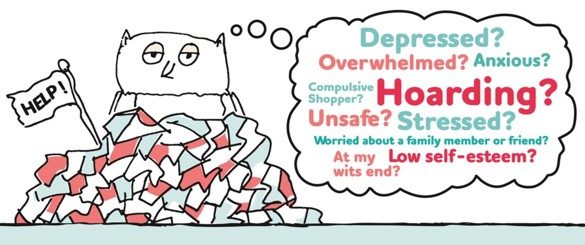Clutter Image Rating Scale
The Clutter Image Rating Scale consists of three sets of nine images showing an increasing amount of possessions have built up in a bedroom, kitchen and living room – with 1 being a few items on the floor, to 9 being about the height of a door.

Group Treatment for Hoarding Disorder: Appendices. Copyright © 2014 by Oxford University Press
Oxford Clinical Psychology | Oxford University Press
The concept can be applied to other spaces (whether it be rooms, gardens, sheds, vehicles, offices, etc), and is widely used by the emergency services (especially fire services), social services and Professional Hoarding Practitioners around the World as a way of measuring and reporting the extent that a space has become engulfed in possessions.
It can also be used very effectively to start a conversation with someone about their space, and gauge the level of insight they have (or may not have) about related health and safety issues.
It was originally devised back in 2006, as part of a study by Professor Randy O Frost (Boston University) , Gail Steketee, David Tolin and Stefanie Renaud, and was first published in the Journal of Psychopathology and Behavioral Assessment. 2008;32:401–417.
Click here to download a free copy of the Clutter Image Rating Scale.
Hoarding Support Groups
Click here to find a map of Hoarding Support Groups in the UK. They’re open to people living with hoarding or clutter-related issues, and their families and supporters. Choose from meeting other people in person, or online or over the phone.

This video – Keith’s Story – explains about hoarding and how taking the first step of attending a Hoarding Support Group can really help a person’s recovery.
Online support

Hoarding.Support (previously known as Help For Hoarders) was founded by Jasmine Harman (presenter of “A Place In the Sun” and “My Hoarder Mum and Me”, and offers information, support and advice for people with hoarding behaviours and their loved ones – plus a forum for sharing experiences, hints and tips.
Professional Hoarding Practitioners
Click here to find a map of Professional Hoarding Practitioners in the UK
Books

“Understanding Hoarding“ (published by Sheldon Press) – by Jo Cooke – a Director of Hoarding Disorders UK CIC – aims to help those with hoarding difficulties, those that live with them, friends and professionals who wish to understand this debilitating condition.
It’s easy to read and packed with practical advice from professionals and those with personal lived experiences of being affected by hoarding behaviours – including family members.
GP Leaflet & Poster
Click here to view a leaflet which will help GP’s understand more about hoarding behaviours, and ask them to display this poster in their surgery, along with copies of the Hoarding Ice-Breaker Form.
British Psychological Society
In 2016 the British Psychological Society (BPS) published a free to download 24 page booklet entitled “Understanding Hoarding“, by Sophie Holmes (Lead Consultant Clinical Psychologist, Sussex Partnership NHS Trust), Dr Stuart Whomsley (Clinical Psychologist & Formerly PR & Communications Lead, Division of Clinical Psychology) and Dr Stephen Kellett (Consultant Clinical Psychologist, University of Sheffield and Sheffield Social and Healthcare NHS Foundation Trust). A version entitled “A Psychological Perspective on Hoarding” by had previously been published in 2015.
- As with many papers and books about hoarding behaviours that were published pre-2018, OCD featured heavily as a likely contributory factor – hence why Hoarding Disorder was categorised under OCD in the ICD-11. However, since then research has shown a strong connection between Neurodiversity, trauma (including Adverse Childhood Experiences – ACEs) and chronic disorganisation/hoarding behaviours.
Hoarding Awareness Week – #hoardinghelp

The first UK Hoarding Awareness Week (HAW) was launched at the Houses of Parliament in London (in May 2014) by the National Fire Chief Council (formerly the Chief Fire Officers Association), Heather Matuozzo of Clouds End CIC and Cherry Rudge of Rainbow Red (who went on to create the Hoarding Ice-Breaker Form).
Their aim was to raise awareness of the safety issues related to hoarding behaviours, and it has gone on to become an annual event, supported by conferences and plenty of positive media coverage.
As a result, there is more understanding of Hoarding Disorder as a mental illness (and the types of things that can cause it) and the challenges associated with it.
The Hoarding Ice-Breaker Form is listed on their resources page – check it out: http://hoardingawarenessweek.org.uk/resources/
HoardingUK charity

The charity HoardingUK offers support with issues that can affect people with hoarding issues, incl:
- Advocacy
- Benefits Helpline UK – 07444 053 520
- Eviction Threat
- eBaying unwanted items
They also organise hoarding conferences which aim to educate people about the realities of hoarding, and squash the myths and stigmas associated with this very emotive subject.

